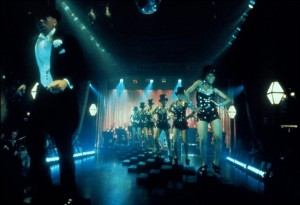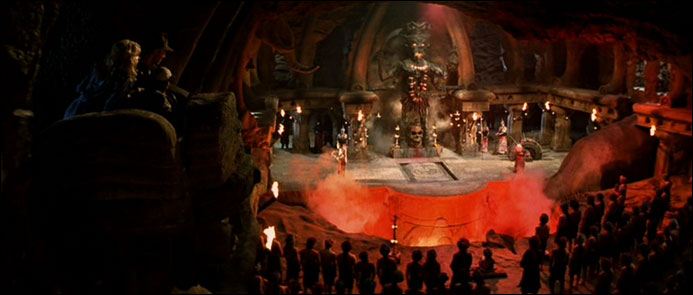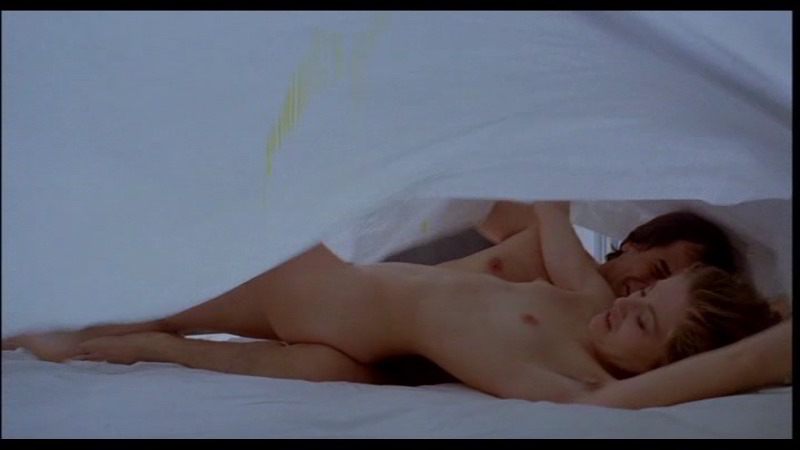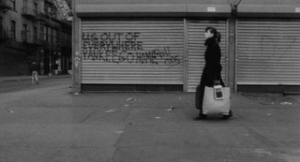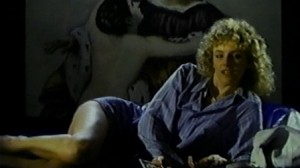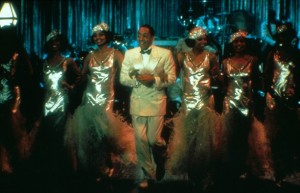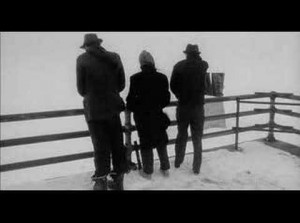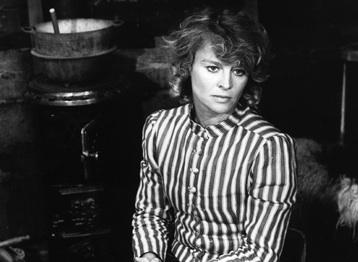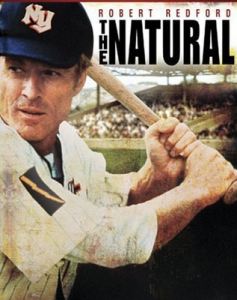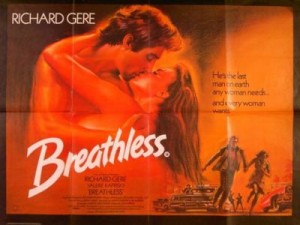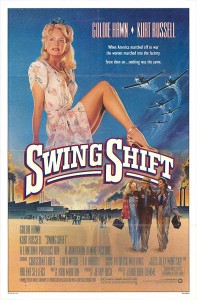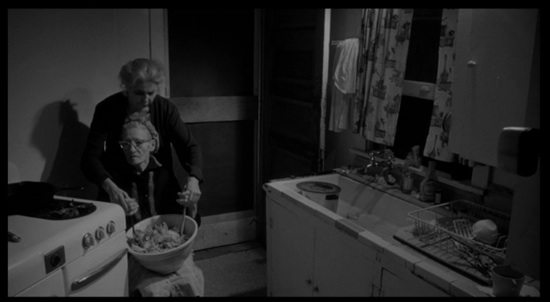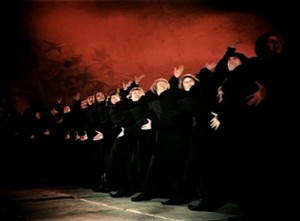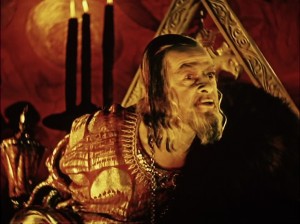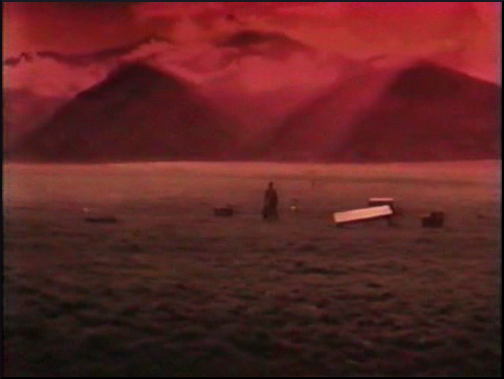From Sight and Sound (Summer 1985). This is a revised and expanded version of a lecture given at the Rotterdam International Film Festival’s Market in early 1985, the second year I attended the festival. Some of it’s obviously very dated now (hopefully in a way that’s historically instructive) and some of it anticipates a few of the arguments made in my book Movie Wars: How Hollywood and the Media Limit What Films We Can See 15 years later. The late Huub Bals, director and presiding spirit of the Rotterdam festival, asked me to give this talk, and, as I recall, it was well attended; the audience members included, among others, Eszter Balint (the female lead in Stranger Than Paradise), Bernardo Bertolucci, Sara Driver, Jim Jarmusch, and Rudy Wurlitzer. –- J.R.
A feeling of having no choice is becoming more and more widespread in American life, and particularly among successful people, who are supposedly free beings. On a concrete plane, the lack of choice is often a depressing reality. In national election years, you are free to choose between Johnson and Goldwater or Johnson and Romney or Reagan, which is the same as choosing between a Chevrolet and a Ford — there is a marginal difference in styling. Just as in American hotel rooms you can decide whether or not to turn on the air conditioner (that is your business), but you cannot open the window.
— Mary McCarthy, Vietnam, 1967
I await the end of Cinema with optimism.
— Jean-Luc Godard, Cahiers du Cinéma, 1965
Twenty years later, both these general sentiments describe an impasse in American life that is vividly reflected in the movies we see and the ways that we see them. If the range of cultural choices apparently available at any given time merits some correlation with the range of political choices, it is also true that Godard’s optimistic apocalypse he a new scale of values, though we don’t yet know enough about these to be able to judge them with any security. Significantly, the Los Angeles critic David Ehrenstein concludes his recent book, Film: The Front Line 1984, by citing Godard’s remark, I implying that avant-garde film-makers of the mid-80s hover over the same ambiguous threshold as everyone else. Whether we condemn or applaud the prospect, a first priority might be a simple evaluation of where we are.
It probably isn’t being too presumptuous to assume that, in one way or another, everyone reading these lines is awaiting the end of some kind of cinema, either optimistically or pessimistically. Whatever name or interpretation we give to this climate, we probably all feel that something is in the process of ending — unless we feel it has ended already. Something is also in the process of beginning; but whatever we choose to call it, I don’t think we can call it cinema in the old sense. Just as the widespread interest in film that characterised the 60s was superseded in the 70s by a widespread interest in film-makers, theagnosticism about narrative which began with the Nouvelle Vague has ultimately led to a belief in headlines rather than stories — a belief that can be found throughout the mainstream of contemporary American media. This change in attitude can be detected in the way news is reported on American television as well as in the more obvious forms of popular entertainment. To cite Godard again (speaking more recently, in Wim Wenders’ Room 666), ‘in Dallas there is no story.’
When one hears that firms in Seattle and Toronto are planning to colour in old black and white Hollywood classics on image processors and release these coloured versions on videocassettes, it certainly feels as though we’re at the end of something. There are plenty of other signs. One can look at the hysterically fragmented editing of Dune and The Cotton Club (which again reduces narrative to nothing but headlines), or the growth of cable TV, or the repackaging of old films on tape and laser disc or the proliferating academic study of film in the United States –four interlocking phenomena which I will shortly discuss in more detail — and get the same sense of a historical period being sealed off, so that the past isn’t only another country but a different planet, a different language, a different set of aspirations. Like Mary McCarthy, we can learn this new language well or badly and say all kinds of different things with it, but we can’t use it to lead us back to cinema in the old sense (cinema, let us say, that was still on speaking terms with the era of Griffith, Murnau and Stroheim). That’s a window which has been nailed shut, and unless we break through the glass — destroy the institutions and the technology which separate us from the past — we have to get used to living in air conditioning.
One central fact about the new American climate is that neither poetry nor criticism are publicly acknowledged as attractive vocations today, except as means to an end, which is power. To be more specific, twenty years ago, when I was a college student, several of my classmates wanted to be poets or critics. As a college teacher, I’m exposed to a fair number of students today, and if any view themselves as potential poets, they keep this information to themselves. A friend of mine in his early twenties who writes like James Agee and is a Harvard drop-out has no professional or vocational interest in writing either poetry or criticism; he writes Hollywood scripts and his ambition is to direct them. I think his situation is characteristic; and as a corollary to this, most ambitious film critics I know in the States aspire to be not better critics, but more powerful. The irony is that, in the 40s, Agee himself aspired to be a film-maker.
Students want to be directors or critics more than they want to direct films or write criticism. The legacy of auteurism is still with us, and while the death of the author may be an established fact in film theory and (not incidentally) most commercial film-making practice, it carries precious little weight in the more groupie-oriented media. Even when half the myth dies, the other half lives on, and if students don’t aspire to make David Lynch’s Dune or Francis Coppola’s The Cotton Club, they still aspire to be David Lynch or Francis Coppola. They don’t aspire to make Chaplin’s A King in New York, which in 1957 Rossellini had the wisdom to call the film of a free man. I don’t think anyone with eyes or ears could seriously call Indiana Jones and the Temple of Doom or The Cotton Club or Dune the films of free men, but they’re certainly perceived as the films of powerful men — men, let us say (and certainly not women), who are allied to power — and that’s what seems to count finally, both in the U.S. and elsewhere.
From the standpoint of film criticism, the intellectual climate in New York today is impoverished compared with that of either London or Paris, and the reasons for this are, I think, ideological. During a visit to New York from London in the mid-70s, I attended a press show and remember being struck by the contrast with press shows in London, where drinks are often served after the film and critics are encouraged to talk to one another about what they’ve just seen. I asked a prominent New York critic why this practice was less common in the States, and he replied, ‘You can’t talk about a film right after you’ve seen it — other critics might steal your ideas!’In London, where ideas are less likely to be seen as private property, critics are often delighted if their ideas are stolen, because this means that their ideas have power. In New York, only the critics are supposed to have power, and the ideas have to fend for themselves.
A few years ago, shortly before Antonioni’s Identification of a Woman was screened at the New York Film Festival, Vincent Canby wrote a review in the New York Times suggesting that Mr Antonioni should study the films of Woody Allen if he wished to make films that were less pretentious. As a direct consequence, scores of advance tickets were returned to the box-office, and the distributor who planned to release the film dropped it like a hot potato. One could cite many such stories, but the point is that the relative isolation of New York critics from one another, bred mainly by competitiveness (and such practices as ‘special’ screenings for powerful individuals), not to mention their collective isolation from critics elsewhere, has led to a gradual deterioration in the intellectual climate since the 60s. The final irony, of course, is that to have a lot of power as a film critic in the U.S. usually means, in one sense, to be owned by the film industry. Which is another way of saying that power of this kind is ultimately institutional rather than personal, despite some appearances to the contrary, and that the industry and general public are usually in agreement that popular criticism is merely a subdivision of promotion, which is run by institutions. The reason, in fact, why certain American critics are accorded superstar status is precisely the degree to which they reflect the institutionalised power of the industry.
If a characteristic American publication of the 60s was The Village Voice or Rolling Stone, perhaps the equivalent magazine today would be People. At present, The Village Voice, despite a few sophisticated writers, is fundamentally governed by an omnipresent house style and a fixed set of attitudes which are possibly even more rigid than those of Agee’s former employer, Time, in its heyday. In terms of the Voice‘s relation to ‘difficult’ films, its position of power remains important, but its service policy of dealing with pre-determined and pre-digested genres and institutions severely limits its value as a news publication. For instance, one can read almost nothing in the Voice about the burgeoning underground movement of chiefly Super-8 films and videotapes shown regularly in such clubs as The Pyramid, Limbo Lounge and Danceteria. It was at one of these that I first saw a 35mm projection of The New World, the first part of Stranger than Paradise, and while the atmosphere there was hardly conducive to close analysis, it is nevertheless quite unremarkable that the Voice chose not to cover the event. What it chooses to cover, and only partially, are works shown in cinemas and by institutions — in contrast to the regular coverage given to more marginal films by Jonas Mekas in the Voice twenty years ago, which included reviews of works in progress which he saw in private lofts.
In a recent Variety article by Linda Beath of Spectra Films, one reads that 1984 was a peak year for foreign films in the States, although signs of the industry’s ‘waning enthusiasm’ were already visible ‘by the middle of the year’. On the one hand, ‘While the annual surveys prior to 1983 listed only one to three films with subtitles earning $1 million or more domestically, in 1983 over twenty-four titles tallied box-office figures of over the million dollar mark”. But at the same time, ‘The massive acquisition policies of 1982 and 1983 had produced results that were financially unsatisfactory to the studio accountants, and to distributors and exhibitors alike.’ The article reports that many French producers are now concentrating on smaller budget films, aimed solely at their native market or larger budget films aimed at conquering the U.S., but with equity participation by American investors.’ More generally, it predicts that 1985 may see some increased exposure for art films on pay TV and videocassettes, ‘but the late 80s look much more interesting.’
It’s all a matter of relativity, of course. When I was in New York for two weeks last Christmas, by far the best new film I saw was Mark Rappaport’s nearly finished Chain Letters, which Rappaport showed me on an editing table. The odds on such a film getting a decent run in New York or Rappaport making any more 16mm features for under $150,000 seem abysmally low, I’m sorry to say, and once again, it looks as though European institutions are having to come to his rescue.
For the time being, though, we have the extraordinary success of a low-budget, independent feature called Stranger than Paradise — another film made in freedom and, incidentally another which celebrates anything but power. The media’s attitude towards this is, of course, to try to turn writer-director Jim Jarmusch into another Jonathan Demme or David Lynch — that is, to assign power not to powerless people but to an image of powerless people, including a supposedly powerless director (and, secondarily, to drown the film in a flood of hype that its legitimate virtues could not possibly support).On the surface, at least, it may seem to resemble a Preston Sturges version of the American Dream come true.
Even the media can’t hide the paradoxical fact that Jarmusch enjoys a kind of working freedom which Lucas or Coppola can only dream about, or hype into media existence. To be more specific, if we can speak of the spectator’s freedom being closely linked to the freedom of the film-maker, I think one can say in Bazinian fashion that the freedom of Stranger than Paradise has something to do with the use of long takes, and the absence of freedom in Dune and The Cotton Club has something to do with rapid editing. Significantly, both films are fantasies of other periods mired helplessly in the present. while Stranger thon Paradise deals with the fantasies and realities of people who. like the spectators of Dune and The Cotton Club, are stuck helplessly in the present.
The fragmented editing associated with Eisenstein has by now degenerated through TV commercials to the point where it achieves its apotheosis in the average rock video, through a form which equalises and synthesises all sorts of contradictory and incompatible material into a kind of affectless mush supported by a disco beat (Giorgio Moroder’s efforts to turn Metropolis into a feature-length rock video, well analysed by Thomas Elsaesser in a recent Monthly Film Bulletin, may represent the apogee of this genre.) And sustained, contemplative lingering over a mood, idea, person, object or event is anathema to this kind of discourse. The makers of Dune and The Cotton Club sacrifice their greatest potential strengths — respectively, the visual gifts of David Lynch and the talents of several black dancers — to the nihilistic dictate of the music video, which supposedly assures the widest possible audience. Consequently, the non-narrative aspect of Lynch’s visual imagination and the qualities of pure spectacle found in dance are torn asunder by a frenetic montage monster born out of computer demographics which prevents us from looking too long or too closely at anything. Both films have seemingly busy narratives which lead nowhere, because they lack the dramatic variations which make narrative compelling.
By contrast, the narrative of Stranger than Paradise is spare and uncluttered, which leaves the audience free to look at the actors and locations. Ironically, one sign of this freedom is the characters’ recognition of their own confinement: as Eddie says of Cleveland, ‘You come to some place new and everything looks the same.’ More concretely, it is the kind of narrative space in which film-makers, characters and spectators are all free to make mistakes and explore alternatives simply by virtue of the fact that they’re all free to keep moving, without being hampered by computer demographics.
It should be added that the lessons of such a success are not entirely lost on Hollywood, even if Hollywood invariably translates these lessons into bigger budgets. As evidence of this, an article by Dale Pollock in the Los Angeles Times early this year is illuminating:
In a new plan beginning today, the union will reduce the up-front
Pay for directors, assistant directors and unit production managers
by 50% for movies that cost less than with $1.5 million, and by 40%
for feature films that cost between $1.5 million and $2.5 million.
The guild characterizes the plan as ‘an unprecedented move for the
Motion picture industry’ […]
‘The time has come to recognize the problem that there are a lot of
Productions out there that are not using our people,’ Michael Franklin,
National executive director of the guild said Monday. ‘Non-union films
Are increasing. We have to start coming to grips with this.’
The article goes on to cite Alan Rudolph’s Choose Me and, John Sayles’ The Brother from Another Planet as recent successes that cost less than $1 million. It adds that, in a recent interview, Sayles said he had to resign from the Directors Guild because he could not afford to pay his own guild-mandated salary, plus that of an assistant director and unit production manager, from the $750,000 budgeted for his last film.
This de-escalation offers a hopeful sign, but it is clearly not enough to guarantee freedom. The relative roles that can by played by stars in Europe and the U.S. is instructive. While the presence of Delphine Seyig in Jeanne Dielman and Julie Christie in The Gold Diggers enabled Chantal Akerman and Sally Potter to make the films they wanted in 35mm, the power of final cut held by certain American superstars such as Robert Redford, Richard Gere and Goldie Hawn has virtually sabotaged such films as The Natural, the remake of Breathless, and Swing Shift.
***
Sometimes freedom at the production level can be translated into commercial success only when the distributor and/or exhibitor decides to nurse an unusual film through a difficult period until it achieves box-office health: Ben Barenholtz’s handling of Eraserhead and Dan Talbot and Jeff Lipsky’s handling of both Chan Is Missing and My Dinner with André are models of this delicate process. (Regarding the latter film, I recall a rather desperate transitional period when a free screening in New York with complementary wine and cheese was offered to the public in an effort to stir up interest.) But this is the work of individuals, not institutions or computers. If the American Film Institute miraculously co-produced Eraserhead and the most intelligent film programming in the us is to be found at Pacific Film Archives in Berkeley and the Art Institute of Chicago, this is clearly the work of certain people at the AFI as well as Edith Kramer and Richard Peña, and only secondarily the institutional bases at their disposal. One can only turn back to the AFI to see the effects of institutional power being used to preserve the status quo.
In a recent issue of American Film, Charlton Heston (whom Michel Mourlet once called an axiom and who today, as axiomatic as Ronald Reagan, is president of the AFI’s board of trustees) expressed amazement — his word — at the discovery that the film author’s editorial control was established by French law in 1957. After implying previously in an article that French directors who benefited from state subsidies — presumably film-makers such as Bresson, Rivette and Demy — were denied the creative control of people like Spielberg and Lucas, Heston drew fire from Michel Ciment and Marcel Ophüls, and promptly conceded his error, but none the less concluded that ‘To suggest that creative control can be legislated in a democratic society is, I think, debatable.’ Which I interpret, rightly or wrongly, as meaning that in a capitalist society, legislating culture in any manner is denying full creative control to capitalists.
But Heston’s misapprehension of creative control in France is merely symptomatic of a general crisis in communication between the U.S. and Europe which the so-called ‘communications explosion’ can only exacerbate. The brutal truth is that communications equipment often reduces our capacity to communicate. Think of the increasing role played by telephone answering machines in urban society and you have a model for the double-edged role played by video technology in relation to the media. Thanks to cable TV, Americans live not in a global village but in a loose network of estranged communities, scattered feudal strongholds representing some (but by no means all) minority positions. Avant-garde film, for instance, has so far made few inroads in this area, sometimes for understandable reasons but sometimes due to ignorance or inertia. The growing popularity of some non-narrative tapes-ranging from rock videos to ‘wallpaper’ videos (four hours of fish swimming in a tank or a fire in a fireplace to soothe the nerves) may even be taking some of the edge off the avant-garde, weaving its transgressions into the texture of everyday banality.
On the other hand, at a shop in New York called New Video, one can rent or purchase tapes of films by Mark Rappaport, Sara Driver, Jim Jarmusch, Yvonne Rainer, Richard Foreman, Jonas Mekas and Ken Jacobs. I bought a VCR last summer, and while I may be years behind some of my European friends with video recorders, I already have VHS copies of Ballet Méchanique, Le Charme Discrèt de la Bourgeoisie, Enthusiasm, Gentlemen Prefer Blondes, Ordet, Playtime and Ugetsu Monogatari, which are invaluable to me as a teacher and critic. Playtime with its wings clipped for a video format is hardly the whole film, but it is still a useful reference tool. In the United States now, it is, significantly, easier to acquire lvan the Terrible, Part II with correctly timed colour on videotape than on film.
At the same time, it’s clear to me that my videotape library radically alters the impact and meaning of the films in my possession. Some of the pleasures afforded by the original films are no longer available, while others are available for the first time, such as the Barthesian pleasure of scanning or skipping through a text with a fast-forward button. The big question is whether, once the unattainable text becomes attainable, we learn anything crucial about it that we didn’t know before. I’m not sure that we do: but, on the other hand, once this new power is put to use by artists and critics working directly on video — artists and critics who address themselves to the parameters of this new form of pleasure — new forms of knowledge may well become possible.
Even now, video recorders open the way to creating new texts by intercutting between old texts, and I suspect that in the years ahead this option may create a new genre of intertextual bricolage. Indeed, we already have the phenomenon of the ‘found footage’ film, a genre of the avant-garde stretching from Joseph Cornell to Bruce Connor to Ken Jacobs that has more recently been taken up by everyone from Orson Welles (F for Fake) to Edgardo Cozarinsky (La Guerre d’un Seul Homme), from Raul Ruiz (Petit Manuel d’Histoire de France) to Ken Russell (The Planets), from Woody Allen (What’s Up, Tiger Lily?) to Carl Reiner (Dead Men Don’t Wear Plaid). Collectively, these films propose a sort of anti-Bazinian, Vertovian revolution whereby découpage replaces mise en scène and. the director’s chair makes way for the editing bench – a movement that can only gain in intensity as it falls within the potential grasp of everyone with a VCR. Video technology takes a public art like cinema off the streets and places it on the shelf for private consumption. It answers the need of the son of Dr Mabuse in Lang’s last film by facilitating the form of one-way, involuntary communication which we call surveillance. It. even combines these two functions in a sense when it turns us into active voyeurs rather than passive spectators of art. To think about contemporary video technology-which includes laser discs, high-definition video, Advent screens, image processors and all the rest — is to think about armaments and weaponry. The pause button on a VCR confers some of the power of a trigger — the power to stop something or someone dead in its tracks — even if the pause button has an additional capacity which the trigger does not of bringing the dead back to life again. And when we stockpile films on cassette the way that countries stockpile weapons or computers stockpile information, what does this do to the word-of-mouth communication we associate with public forms like theatre and cinema? The unique capacity of video is to make the work mortal and immortal at the same time, a form of survival through mutation — or death through embalmment.
***
The nature of our desire in relation to films is undergoing a subtle yet radical change. Expressions of that change are visible everywhere: in the narrative crisis posed by Dune and The Cotton Club, in the possession of the film text made possible by cassettes, and in the contradictory optimism and pessimism of a film like Room 666, which evokes an impossible transcultural blend of Michael Snow’s Wavelength and a table ronde in Cahiers du Cinéma. To understand the present American climate, one should look at a recent Hollywood film, The Terminator, which gives full expression to two important facets of this new desire: namely, the desire to be a machine, preferably a computer, and the anticipation of a holocaust as the prerequisite for a plausible happy ending. The surprising thing about The Terminator is how fundamentally cheerful it seems, given what it has to say. When the computer-villain (Arnold Schwarzenegger) has to decide how to respond verbally to someone pounding at his door, and a printout of the choices appears in his brain (and ours), the moment is an epiphany of delighted identification: we’d all love to have our own creative decisions broken down so succinctly.
Imagine a remake of Alphaville with Alpha-60 as the hero — an Alpha-60 who has absorbed and refined both the brutality of Lemmy Caution — and the iconography of Schwarzenegger -– and you have a new form of utopian, neo-Sternbergian erotics, shared equally by Blade Runner, which views the present both as a sordid, densely claustrophobic jungle and as a desirable place to be. Ruiz, in his very different fashion, expresses some aspect of the same desire, rerouted through leftist politics — although for him, as for Godard, the computer-hero is replaced by the myth or the metaphysical system. The recurring image in at least three of his works (Utopia, Colloque de Chiens and Le Borgne) of a corpse cut into pieces which are buried in diverse hidden locations is a precise metaphor for Ruiz’s own oeuvre and his sense of his own scattered authorship. Ruiz, of course, is a phenomenon conceivable only outside the U.S. — which helps to explain why his films still have had no appreciable stateside impact. Significantly, it was Ian Christie, Paul Taylor and Nigel Algar of the BFI who enabled me to see about a dozen of his tapes and films last summer. Trying to explain to American spectators the cultural system that makes a Ruiz possible would be a formidable task, and it’s hard to determine even where such a discussion could take place.
During my own utopian reveries, I sometimes wonder what it would be like to see Ruiz’s half-hour short Le Jeu de l’oie (Snakes and Ladders) or Straub-Huillet’s En rachachant on an American cable channel like BRAVO. Some of the obstacles which prevent this may eventually prove to be more apparent than real. Over the past year, at least four so-calIed ‘difficult’ features — Maurizio Nichetti’sRatataplan, Samuel Fuller s White Dog, Jerry Lewis‘ Smorgasbord (retitled Cracking Up) and John Jeremy’s The Long Night of Lady Day — premiered in the U.S. on cable without any sort of theatrical release, conveniently bypassing the almost certain mauling and misapprehension most of them would have encountered from the press, and thereby reaching audiences more directly and without interference. On a much more modest yet I believe related level, it was possible last year to book a print of Ruiz’s Le Toit de la Baleine for a film and photography conference at the university where I teach. That virtually no one on campus had heard of Ruiz didn’t prevent a sizable crowd from turning up, given the context in which the film was shown. While responses were mixed, one could argue that the absence of media fanfare again proved more of an incentive than a deterrent. If this means the end of film criticism, let me rephrase Godard — I await the end of film criticism with optimism.
Cable is offering a good deal already, which makes one optimistic about it opening up further. While the best film channels like BRAVO and Z aren’t available everywhere — in Santa Barbara I can’t get the latter and New Yorkers can’t get either, but people in Los Angeles can get both — the monthly offerings are still impressive. This year alone (I write in early spring), BRAVO has already shown films by Bergman, Bertolucci, Buñuel, Fassbinder, Fellini, Forsyth, Greenaway, Herzog, Kurosawa, Max Ophüls, Resnais, Saura, Syberberg, Truffaut and Welles, among many others; SPN has offered films by Griffith, Lang and Murnau; the Disney Channel has just concluded Monsieur Verdoux and A King in New York, and even American Movie Classics offered good prints of Rio Bravo and the original Scarface. In most cases, the films are shown complete and without interruption. BRAVO precedes each film with a mild but usually not unintelligent critical introduction, and shows virtually every foreign film in both subtitled and dubbed versions. It’s encouraging to hear that the subtitled versions are watched more often.
We all know that certain difficult films can reach their audiences only by word of mouth, and it is here that cable may have more of a future than theatrical showings. In the cinemas today, word of mouth is probably more hamperedthan helped by the press, because the language of popular criticism usually offers too debased a model. (At the moment a critic becomes a star, the critical discourse becomes a nightclub act.) Teaching film criticism workshops, I’ve met an increasing number of students who assume (from the evidence of their first papers) that film criticism is a form of advertising, to be written in the kind of aggressive jargon that deals only in superlatives and ultimate categories — a jargon where ‘all time’ invariably becomes the equivalent of ‘yesterday’. Yet considering what they have been exposed to on network TV, and in newspapers, weeklies and non-academic film magazines, how could one realistically expect them to assume anything else?
On the other hand, in universities and among friends who have access to cable and/or collect cassettes — that is to say, in the more private and less ostentatious sectors — people are often finding it easier to deal with difficult or marginal films and discuss them without having to depend upon the beneficence of a Canby, Corliss, Denby, Kael or Hoberman. It isn’t these critics but the positions they occupy which ultimately limit our choices, and these positions are created in turn by the pressures and cost of opening a film theatrically in New York. (It costs a sobering $40,000 now to launch any feature there on a single-screen basis.)
The growth of multiplex cinemas in places like Toronto and Los Angeles allows for wider programming, and arts centres from Buffalo to Minneapolis to San Francisco bring in still more. But it’s chiefly cable and academic film studies that are beginning to redistribute the exclusive power and influence held until now by New York a little more equitably around North America, and in productive and unpredictable ways. It’s the Midwestern film departments which dominate much of the important work
being done in film theory and film history, for instance; and at the Toronto Festival of Festivals last September, there was a strong movement afoot to liberate the Canadian avant-garde from its position as an American colony –- a parallel to certain developments in the British avant-garde over a decade ago.
***
But cable and academic film study are both limited insofar as they still most often traffic in the already known, and the conservatism of most film criticism now is that it effectively does the same. One direct result of this current crisis in communication caused by ‘communications’ is that we don’t really know as much as we should about the kinds of film-making that are going on around us. For this reason, I feel myself in conflict with those critics writing from institutional bases who’ve indicated that 1984 was a bad year — or a good year — for films in general. My conflict is not that I disagree but that I can’t see how any of us as critics or programmers are in a position where we could possibly know something like that.
It’s here that institutional power becomes most sinister, asserting critical notions and structures of closure rather than open forums and open texts. No matter how many films we see, we’re only glimpsing a tip of the iceberg and often misreading the tip that we do see; I don’t think we’re necessarily much better than our predecessors in this respect. Without the benefit of word-of-mouth communication of the sort we had in the 60s — which was a time when the media was both less monolithic and less trusted, and when not only could a student uprising in New York help spark off a much bigger one in Paris, but a film like La Chinoise could help spark off both — we can no-longer assume that most of the best and most relevant work is automatically finding its way to our doorsteps. The media has to assume this in order to predict its own credibility; but this doesn’t oblige us to assume it as well.
Nevertheless, there are plenty of maverick triumphs around, with varying degrees of visibility. These are scattered phenomena, not symptoms that can easily be packaged into any particular trend — although it might be noted that many of these works presuppose a certain sophistication about filmgoing as a conscious activity. Choose Me demonstrates for the first time that the formal play with parameters of acting and fiction found in Rivette is translatable, up to a point, into a popular and accessible Hollywood comedy. Chain Letters proves that the lighting and colour coding of a Written on the Wind are attainable without a Hollywood budget, while 1984 confirms the lesson already imparted by Olaf Stapledon in the 3Os — that science fiction with literary depth is fundamentally grounded in an acute sense of the present as a particular time and place — with location ingenuity often taking the place of ‘production value’ expenditures.
Given the post-narrative, post-critical, post-auteurist and post-cinematic climate I’ve been describing, it’s hard to generalise about the directions in which audience tolerance is headed; too many coexisting time scales and patterns of development cloud the issue. While Stranger than Paradise popularises the avant-garde’s use of black leader in a musical manner that audiences find pleasurable, avant-garde film-makers such as Leslie Thornton still have to remove all black leader even from extracts of their work in order to get it shown on the so-called educational TV networks in the States. (It has been argued that black leader is read by most TV viewers as a transmission problem, and it must be admitted that it registers quite differently on film and on video.)
Maybe in five or ten years we’ll have complete films or tapes by Thornton, Rivette, Duras, Ruiz, Wenders, Jancso and Straub-Huillet on American cable and/or cassettes — and maybe we won’t. I’m convinced that the audience is there as well as the technology; all that’s needed at this point is mending a few loose cultural connections and giving it a chance. The same holds for non-theatrical distribution on college campuses — or, indeed, anywhere where the life expectancy of a work doesn’t have to depend entirely on the enthusiasm of a mainstream critic.
The author’s thanks to Hubert Bals and Edward Branigan.





